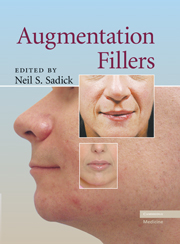Book contents
- Frontmatter
- Contents
- LIST OF CONTRIBUTORS
- Ch. 1 Application of Fillers
- Ch. 2 Approach to Choosing the Ideal Filler
- Ch. 3 Patient Selection, Counseling, and Informed Consent
- Ch. 4 Hyaluronic Acid Skin Derivatives
- Ch. 5 Collagen Products
- Ch. 6 Radiesse
- Ch. 7 ArteFill
- Ch. 8 Augmentation Fillers in Cosmetic Dermatology: Silicone
- Ch. 9 Advanta Expanded Polytetrafluoroethylene Implants
- Ch. 10 Sculptra
- Ch. 11 Lipo Transfer
- Ch. 12 BioAlcamid®
- Ch. 13 Combination of Approaches in Augmentation Fillers in Cosmetic Dermatology
- Ch. 14 Filling Complications
- Ch. 15 Postprocedure Management and Patient Instructions
- Ch. 16 Conclusion: Future Trends in Fillers
- INDEX
- References
Ch. 5 - Collagen Products
Published online by Cambridge University Press: 26 February 2010
- Frontmatter
- Contents
- LIST OF CONTRIBUTORS
- Ch. 1 Application of Fillers
- Ch. 2 Approach to Choosing the Ideal Filler
- Ch. 3 Patient Selection, Counseling, and Informed Consent
- Ch. 4 Hyaluronic Acid Skin Derivatives
- Ch. 5 Collagen Products
- Ch. 6 Radiesse
- Ch. 7 ArteFill
- Ch. 8 Augmentation Fillers in Cosmetic Dermatology: Silicone
- Ch. 9 Advanta Expanded Polytetrafluoroethylene Implants
- Ch. 10 Sculptra
- Ch. 11 Lipo Transfer
- Ch. 12 BioAlcamid®
- Ch. 13 Combination of Approaches in Augmentation Fillers in Cosmetic Dermatology
- Ch. 14 Filling Complications
- Ch. 15 Postprocedure Management and Patient Instructions
- Ch. 16 Conclusion: Future Trends in Fillers
- INDEX
- References
Summary
As collagen has been considered the major building block of dermal structures, it has always been considered an important source for soft tissue injectable implants. Collagen gives support and structural integrity to the skin and associated soft tissue and its loss conversely leads to the thinning and atrophic appearance of both intrinsic and photoaging skin. The triple helical protein structure has a fiber architecture in which intermolecular cross-linking determines the biodurability of collagen in its natural state within the body. The natural balance of collagen degradation and regeneration is upset by UV radiation creating the photodamage that destroys the structure and further leads to dermal loss, facial volume loss, and consequent facial aging (Figure 5.1).
It is no wonder that collagen was early on chosen as a primary substance for all injectable fillers. In the quest for the ideal dermal filler, the following properties were sought:
Ease of administration: the product is readily available in a syringe and is easy to inject with good flow characteristics.
Physiologic: the product fills the space evenly and is malleable yet remains in place, giving reliable early natural results.
No side effects: little or no bruising, edema, inflammation, or other side effects with little chance for prolonged nodules, granulomas, or delayed allergen reactions.
Longevity: three months, six months, a year, or permanent have all been named as ideal life spans for filling materials.
Collagen meets many of these criteria, though no material thus far has been found to be perfect.
- Type
- Chapter
- Information
- Augmentation Fillers , pp. 29 - 42Publisher: Cambridge University PressPrint publication year: 2010
References
- 1
- Cited by



